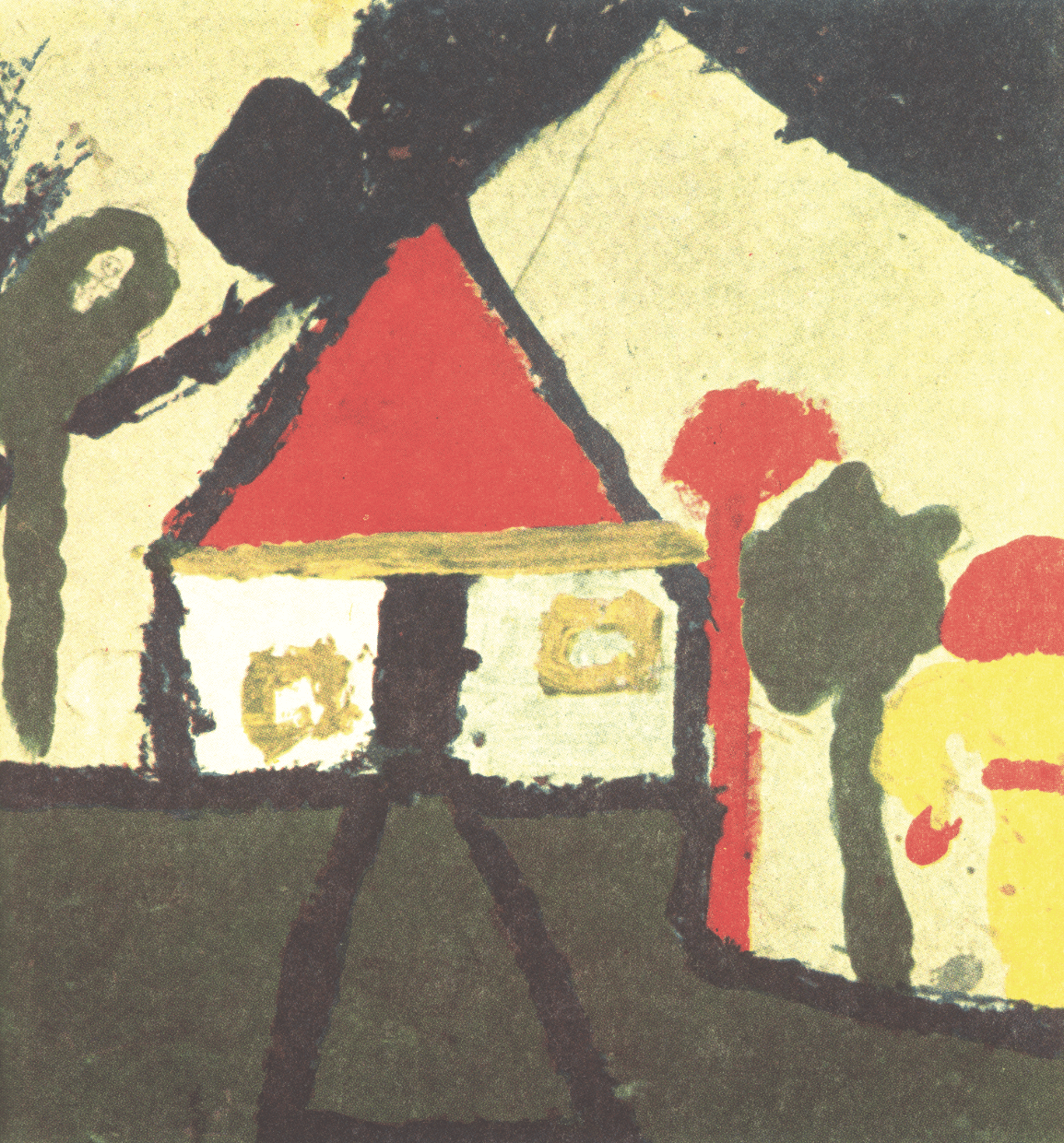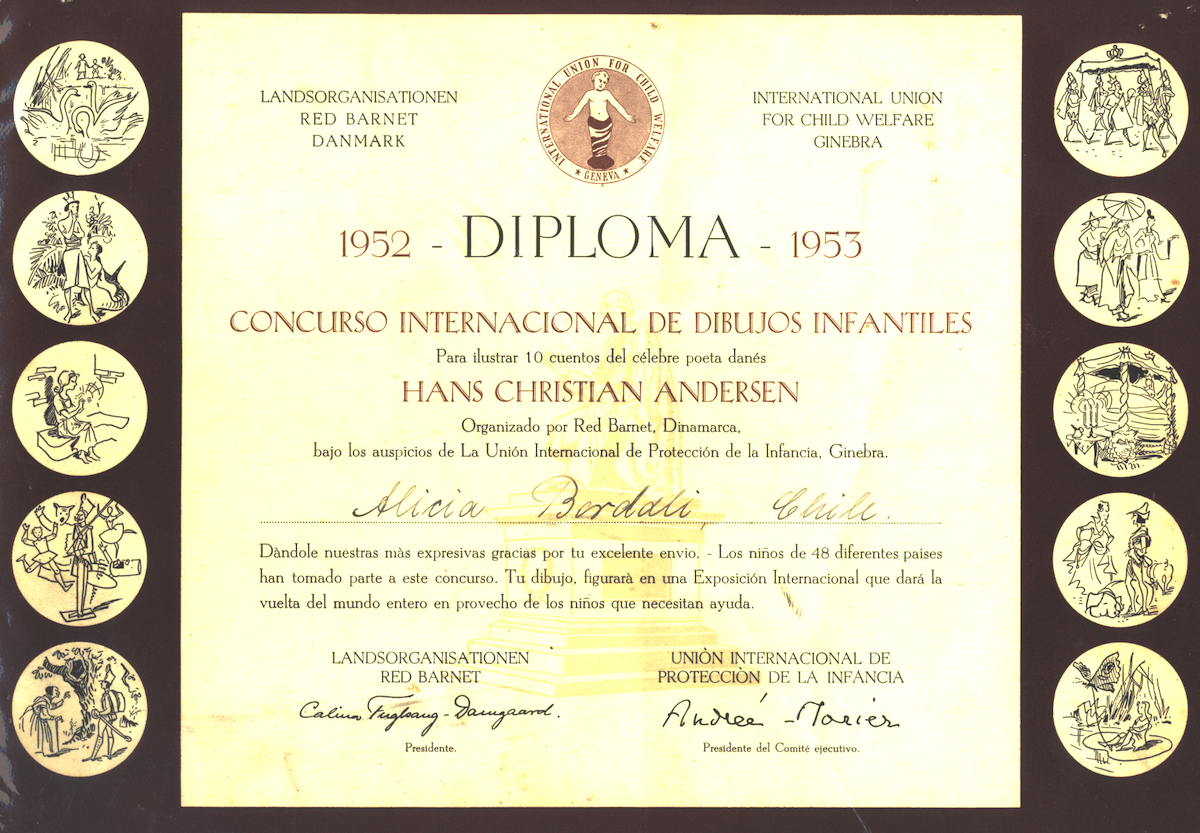
The winning painting by Alicita age 6.
written with love by Cecilia Timm
Alicita
They were so shiny and delicious, a rainbow of colours that would entice any imagination. She wanted them so much. Alicita looked up at her mum and pointed to the wooden box of pencils she wanted. Most six-year-old girls would be happy to stare longingly into a candy store window but Alicita was more excited here, this was her Mecca.
Alicita was special, not because of her blond curls and blue eyes (rare in Santiago, Chile), and not because she was the last happy accident, in a large loving family of 5 children. Alicita was a talented artist, even back then. Her creative spirit had been nurtured and cultivated from the beginning.
Nenna was the eldest and the first grandchild of her generation. She was spoilt by her grandparents and soon learnt to use manipulation as her weapon of choice.
Second in line was George, the only son of the family. He was a charming and charismatic boy with movie star good looks. He was kind, loving and was always looking out for his sisters.
The third to arrive was Carmińa. She was a beautiful, artistic and caring girl, who loved to learn, as much as she could about the arts. At a young age, she became sick, when doctors misdiagnosed a heart condition. She became gravely ill and spent the rest of her short life between periods of relative health and near death.
Meche (Mercedes) was the fourth to join the family. Her nickname was Negrita, as she was painted with a darker brush, with beautiful olive skin. She was the rebellious, cheeky one of the girls and would always seek adventure and trouble.
Finally, Alicita arrived, the baby of the family. She was quiet and chose to sit back and watch her sibling’s adventures, learning from their mistakes. She decided to be a good girl and did not want to rebel against her parents, school or society. She was a quiet observer.
Having the good fortune of being born into a wealthy family, life in Chile was good and none of the children in the family wanted for anything. The best schools, beautiful clothes, housekeepers and nannies were a part of everyday life. Unlike other Latin American families, the girls were not treated with much difference from their brother. The largest difference being of expectation. Being the only boy, George carried the responsibilities of his father’s dreams for his career. The girls were encouraged to learn, achieve and inspire themselves and others. Perhaps their father’s business links with America opened his eyes to a new way of seeing women as he showered his wife with adoration and respect.
Alicita was influenced by all of her siblings, but perhaps most by Carmińa. Carmińa could not be left on her own, for fear she would become ill and that no one would be there to get help. Her quiet life led to her interest in the arts: drawing, writing and painting. She would send away for correspondence courses in drawing and spent hours practising at home. She was very talented. When she was well she would paint in the park, go to the art gallery and sketch for hours as well as write stories and poetry for her family. Alicia would often accompany Carmińa but would get bored at the art gallery, as she would have to wait for hours. She walked the gallery halls, looking at the walls, not knowing the influence they would have on her later in life. She did not know that she had the makings of a great artist.
One day at school, an announcement was made about a competition to select a painting that would represent the children of Chile, for the Hans Christian Andersen International Union for Children Welfare. This organisation wanted to collect one picture from each of 48 countries to make up a travelling exhibition, to raise global awareness of children in need around the world. Alicia was excited about the competition and was counting down the days.
Standing at the art shop window with her mother Alicita was dreaming of the pictures she could draw with the beautiful box of pencils. Her mother could see her desire and promised to get her the box of pencils if she won the drawing competition. Alicita was elated, she was so excited now, and could hardly wait.
The days passed slowly and when the competition day finally arrived, hundreds of students from all over Santiago filled a large hall. It was not until much later in life that she became accustomed to the rows of desks and quiet of exam halls. Each desk was set up with the same equipment; paper, paints and brushes. It was all so serious. There was no favouritism, no chance of getting help with drawings and no noise. “Your time starts now”. The only noise that could be heard was that of moving paper, the occasional cough or shuffling of chairs. The scene was very foreign for Alicita, it was so large and cold, but soon enough the room disappeared, as she picked up her brush and started to paint.
Alicita loved to paint. She chose to paint her house as it was familiar to her. A wide welcoming path made it’s way across the front garden, leading to the front door of her house with two windows on the front. The Andes Mountains rose up in the background as these could be seen from most places in the city, the sky was filled with stars (an image now extinct in Santiago) and her mother stood in the front garden in a yellow outfit.
She had forgotten where she was and as she put down her brush she remembered the competition. Looking around the hall she could see the officials (a group of two men and a woman) walking around the room, looking at all of the artworks on their tiny desks. They circled the room once and then again. On their third time around the room, they stood near Alicita’s desk, speaking seriously and quietly. The lady from the group came up to Alicita’s desk and snatched the picture. She held it above her head and announced: “this is the winner”. The group of officials scattered off with the painting, but one man stayed behind to tell her that a certificate would be sent to her.
Alicita Never saw that picture again.
It was a strange victory. In one way she was elated to have won such a large competition but she also wished she’d had the picture to show the family her masterpiece. This was her first experience of winning and she was not sure what to make of it.
On returning home that day, Alicita was the centre of attention. Everyone wanted to hear her tell the story of how she had been the best child painter in Santiago on that day. She described the painting in vivid detail; every brush stroke came to life as her family asked her to tell the story again and again. That night Alicita was exhausted from her exciting day and dreamt of the house in her painting.
The excitement was short-lived as Carmińa became gravely ill again and a shadow of fear, uncertainty and urgency fell over the house. Alicita’s win was forgotten, as was the box of pencils.
Despite her young years, Alicita understood the seriousness of her sister’s illness and the strain it brought on the entire family, especially on her mother. Despite this, she was still disappointed that her mother had forgotten her promise.
Carmińa was no longer in immediate danger of dying and for a while, Alicita thought her mother might still remember and arrive home one day with the pencils as a surprise, but this never happened. Alicita continued to accompany her sister to galleries, art markets, the park and museums. They would both practice their craft but when Carmińa died Alicita continued to paint and draw on her own. A few of Carmińa’s paintings and poems continued to inspire Alicita to continue her adventures into art.
Alicita grew up to be a beautiful, intelligent and artistic woman. She married at the ripe age of 21 and started a family of her own in Santiago. She then moved to Sydney Australia and continued to bring up her family in a new world. Her art followed her wherever she went and it grew as she did into a beautiful collage of light, love and dreams.
Cecilita
Cecilita was the only skippy in a family of wogs. Her parents migrated to Australia from Chile two years before she was born. Her eldest sister Carolina (Clota) was born in Santiago and was five years her senior. Clota felt very protective of Ceci from the time she was born. Carolina had a life-size doll that she would care for as her own baby, in the same way, her mother did with Ceci. This caring continued and later in life, Carolina always kept an eye on the baby of the house.
Cecilita’s mother had decided to start a new life in Sydney, Australia to give her children the best chance to grow up in a place that would allow them to grow up with the finest possible schooling, opportunities and attitudes.
The girls were always encouraged to explore every aspect of themselves from art and science to sport and music. Both girls were curious and clever, adventuring into projects, clubs and making fun around the house. One day Ceci came across a certificate that was made out to her Mum, it was from The Hans Christian Andersen International Union for Children’s Welfare. Ceci asked her Mum what it was for and she explained that when she was a small girl, not unlike her daughter, she had been interested in the arts. As a girl, Cecilia’s Mum, Alicita knew of an upcoming painting competition, her mother promised to buy her a box of pencils she really wanted but forgot to get them for her when she won the competition.
This story made Ceci sad and she promised herself that one day she would make up for that promise.
This certificate fascinated Ceci as it showed her that one day long ago, her mummy had been a little girl too. This was something she had never really thought of before.
Many years later, when the girls had both grown up, Ceci found that same certificate again and decided to keep it – not to take it from her mother but to help her try to find the picture her mother could barely remember.
Alicia had become a fantastic painter in her adult life and Cecilia thought it could be fun to find the painting that had won such acclaim. In January of 2000, Cecilia started researching the Hans Christian Andersen International Union for Children’s Welfare, attempting to contact them via their website but to no avail. Her emails were ignored. She tried to contact charities associated with Hans Christian Andersen, searched online bookshops, and emailed anyone whom she thought might help.
From time to time Cecilia would try to search again and one day in January of 2003, she found a listing for a Hans Christian Andersen book printed in 1958. It was a collection of stories and was listed as being illustrated, with the drawings of children from around the world.
So many of these searches had ended in disappointment, but Cecilia decided to send an email asking the book’s owner to see if there was a picture drawn by a 6-year-old child from Chile. Four agonising days later, a lady called Laura sent a return email saying that the book she was selling had a picture of that description, but did not list the name of the artist, it just said “Chile, 6 years old”. This had to be it, as the dates were perfect. Cecilia was so excited and could not believe her luck. Laura was kind enough to send through a picture of the artwork printed on page 208 and it fit the description her mother had given her so many years before.
Cecilia bought the book over the Internet and had it delivered to a friend’s house to make sure her mother would not accidentally open the package and spoil the surprise. In the coming months, the book arrived, and Cecilia had the certificate and a picture of the painting framed. She also searched for the most beautiful box of pencils she could find, to fulfil her grandmother’s promise.
Even though Cecilia only had one memory of her grandma, they were close. Cecilia always felt her presence wherever she was, even when she was alone. It was not until she was much older than she realised her grandma was her guardian angel. Over the years she had often thought of her grandma and what she would think of the three of them (Alicia, Carolina and Cecilia) living in Sydney, sharing their lives and enjoying the freedoms that come with being a woman at this time in history. Cecilia could only conclude that her grandmother approved, as she had always found a way to look after the three women and make sure they stay together as they are at their strongest this way.
It is now Alicia’s birthday, she is 58 today. It has been 52 years since she first won acclaim for her art. She is now winning acclaim from anyone who happens to see one of her beautiful paintings. Her talent, beauty and passion are obvious to anyone who takes the time to notice. She is very loved by two daughters who think the world of her and admire her strength, intuition & intelligence and hope to one day grow up to be such a woman.
Mum,
I hope you like your book. It was obvious back then that you are talented and that your work should be published and shared with the world. Keep painting – don’t ever stop. You have so much beauty to share.
The story continues from here and the next page is left blank to fill in the future.
Love
Ceci


